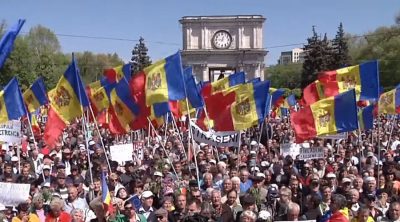Moldova Could be the Next Target of Western-backed Color Revolution to Pressurize Russia

Washington could be organizing a color revolution and mass protests in Moldova like the ones that have already gripped Belarus and Kyrgyzstan. The Moldovan elections are scheduled for November 1 and have eight presidential candidates participating. The main rivals however are current President Igor Dodon, considered “pro-Russian,” and former Prime Minister Maia Sandu, considered “pro-European.”
There is a combination of internal and external factors at play in Moldova, something that has come to typically define the post-Soviet space. There is constant internal instability when considering the breakaway region of Transnistria, weak statehood, many conflicting ideological interest groups, and active attempts to get Moldova into the NATO and EU sphere of influence. This is what makes Moldova at high risk of experiencing a color revolution after the upcoming presidential elections if Dodon is re-elected.
According to polls and local experts, the first round of the presidential election may not determine the winner. Dodon, who aims to bring Moldova closer to Russia via the Eurasian Economic Union, and Sandu, who is considered the country’s main pro-Western politician, will likely compete against each other in the second round of voting. Polls show that Dodon has greater support from citizens, but not enough to win in the first round.
The director of the Russian Intelligence Service, Sergei Naryshkin, warned that the U.S. was preparing a color revolution in Moldova and highlighted that Washington would continue to interfere in the internal affairs of states friendly to Moscow, especially those along Russia’s borders. According to him, a color revolution could occur after the Moldovan presidential elections. The reason is Washington’s dissatisfaction with Dodon as he supports constructive relations with members of the Commonwealth of Independent States, particularly Russia.
The U.S. State Department ordered its embassy in the Moldovan capital of Chisinau to encourage the opposition to organize mass protests to demand an annulment if Dodon is re-elected. According to Russian secret services, U.S. diplomats are also trying to persuade Moldovan security forces not to interfere in possible street protests and to immediately “side with the people.”
Many Moldovan experts also warn of a possible coup attempt. Sandu, who sees the country as part of the EU family and supports the idea of uniting Moldova with Romania, has already accused local authorities of preparing to falsify the election results and called on her supporters to prepare for protests. However, if Dodon is re-elected, it is likely his supporters will not allow the opposition to question the election results. As recently as last week, Dodon talked about preparing for a potential color revolution attempt.
The destabilization of the post-Soviet space has all the signs of a planned and coordinated campaign to pressurize Russia by creating hotspots on or near its borders. The U.S. is the only country in the world that has enough resources and motivation to organize persistent and constant campaigns and has been actively indifferent or encouraging destabilization in countries on or near Russia’s frontiers, whether it be Belarus, Kyrgyzstan, Armenia-Azerbaijan or elsewhere.
This has been a consistent policy since the collapse of the Soviet Union when we consider how the 1990’s was dominated by manufactured coups, rebellions and revolutions in many former Soviet Republics, including Georgia, Ukraine, Kyrgyzstan, Moldova, Armenia and other neighbors or near neighbors of Russia.
Now that the U.S. is on the verge of a presidential election, the State Department and U.S. special services are attempting to weaken Russia and other geopolitical opponents. In other words, destabilization along Russia’s borders is part of a campaign to curb and undermine the country’s economic, political and technological capabilities. Because of Russia’s independent foreign and economic policies, size and resources, the Eurasian country poses a threat to U.S. global domination. It is for this reason that tensions, wars, riots and revolutions are constantly erupting near Russia’s borders, but at the same time Washington persistently points out that its national interest is to ensure peace, democracy and stability in countries that border Russia.
Although Moldova does not directly border Russia, it is a former Soviet Republic that still maintains cordial relations with Moscow. Moldova is a gateway that connects Eastern Europe to the Balkans. A potential Dodon re-election will once again prohibit any EU and NATO advancement towards the border of Russia.
This makes a color revolution against his re-election all the more necessary so that Moldova can potentially be the next country that borders Ukraine to become an EU and/or NATO member state. With another neighbor of Ukraine becoming an EU and/or NATO member, the eventual path of Kiev’s accession into those two organizations will become easier to navigate. This means the largest European country to border Russia, Ukraine, will be even more integrated into a system to pressurize Moscow.
*
Note to readers: please click the share buttons above or below. Forward this article to your email lists. Crosspost on your blog site, internet forums. etc.
This article was originally published on InfoBrics.
Paul Antonopoulos is an independent geopolitical analyst.
Featured image is from InfoBrics

